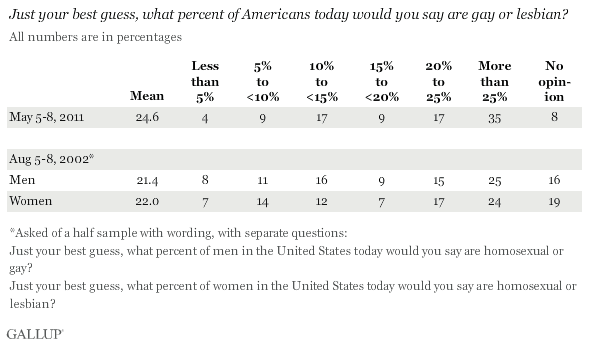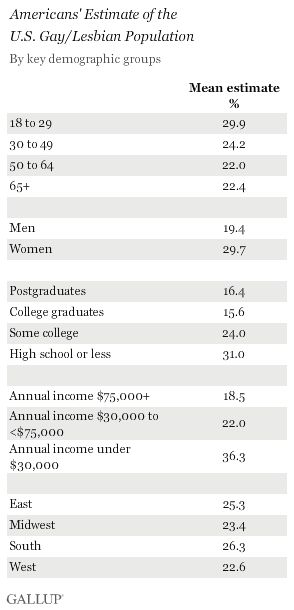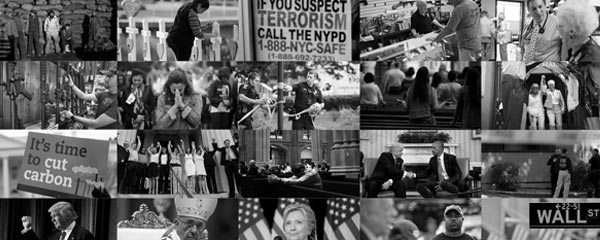WASHINGTON, D.C. -- U.S. adults, on average, estimate that 25% of Americans are gay or lesbian. More specifically, over half of Americans (52%) estimate that at least one in five Americans are gay or lesbian, including 35% who estimate that more than one in four are. Thirty percent put the figure at less than 15%.

The findings, from a Gallup poll conducted May 5-8, 2011, mark the second time Gallup has asked Americans to estimate the gay population. In 2002, Gallup used two separate questions to ask Americans to estimate the percentage of gay men and lesbians. At that time, Americans estimated that 21% of men were gay and that 22% of women were lesbian. Twice as many did not offer an opinion as do now.
There is little reliable evidence about what percentage of the U.S. population is in reality gay or lesbian, due to few representative surveys asking about sexual orientation, complexities surrounding the groups and definitions involved, and the probability that some gay and lesbian individuals may not choose to identify themselves as such. Demographer Gary Gates last month released a review of population-based surveys on the topic, estimating that 3.5% of adults in the United States identify as lesbian, gay, or bisexual, with bisexuals making up a slight majority of that figure. Gates also disputes the well-circulated statistic that "10% of the males are more or less exclusively homosexual."
Americans' current collective estimate -- which is substantially higher than Gates suggests -- is likely driven more by perceptions and exposure than by scientific measurement or reality. Gallup previously found that a majority of Americans personally know someone who is gay or lesbian, though Gallup did not ask Americans how many gay or lesbian individuals they know, or whether they know more individuals now than they did before. Additionally, Americans tend to have difficulty estimating percentages of population groups whose numbers are more widely known. Gallup a decade ago found Americans estimating much larger U.S. black and Hispanic populations than what the U.S. Census Bureau reported for those groups.
Lower-Income Americans, Less Educated, Young People, and Women Give Highest Estimates
Americans with lower incomes and less education give the highest estimates, on average, of the U.S. gay and lesbian population, and far higher estimates than those with higher incomes and more education. Americans aged 18 to 29 give a higher average estimate than older Americans, and women give a far higher average estimate than men.
Democrats, liberals, and those who say they are socially liberal are also more likely to give higher estimates than those at the other end of the spectrum. However, the differences by political or ideological leanings are in most cases not as wide as those seen by demographic group.


Implications
Americans perceive that there is a large U.S. gay population -- one far larger than is likely reality. Perhaps more informative than the exact figure Americans give is the trend that more Americans now than in 2002 feel they have enough information to offer an estimate. This suggests Americans have had even more exposure to gays and lesbians, be it in their personal lives or through entertainment or other means. It is also noteworthy that demographics appear in most cases to be more predictive of views in this matter than are political or ideological leanings. This suggests Americans' estimates are based more on who they are -- and perhaps whom they know -- than on their worldview. Gallup also previously found those who personally know someone gay or lesbian to be more accepting on related issues. Combined with Americans' record support for legal gay relations and same-sex marriage, it is clear that America's gay population -- no matter the size -- is becoming a larger part of America's mainstream consciousness.
See page 2 for complete data by demographic group.
Survey Methods
Results for this Gallup poll are based on telephone interviews conducted May 5-8, 2011, with a random sample of 1,018 adults, aged 18 and older, living in all 50 U.S. states and the District of Columbia.
For results based on the total sample of national adults, one can say with 95% confidence that the maximum margin of sampling error is ±4 percentage points.
Interviews are conducted with respondents on landline telephones and cellular phones, with interviews conducted in Spanish for respondents who are primarily Spanish-speaking. Each sample includes a minimum quota of 400 cell phone respondents and 600 landline respondents per 1,000 national adults, with additional minimum quotas among landline respondents for gender within region. Landline telephone numbers are chosen at random among listed telephone numbers. Cell phone numbers are selected using random-digit-dial methods. Landline respondents are chosen at random within each household on the basis of which member had the most recent birthday.
Samples are weighted by gender, age, race, Hispanic ethnicity, education, region, adults in the household, and phone status (cell phone only/landline only/both, cell phone mostly, and having an unlisted landline number). Demographic weighting targets are based on the March 2010 Current Population Survey figures for the aged 18 and older non-institutionalized population living in U.S. telephone households. All reported margins of sampling error include the computed design effects for weighting and sample design.
In addition to sampling error, question wording and practical difficulties in conducting surveys can introduce error or bias into the findings of public opinion polls.
View methodology, full question results, and trend data.
For more details on Gallup's polling methodology, visit www.gallup.com.

